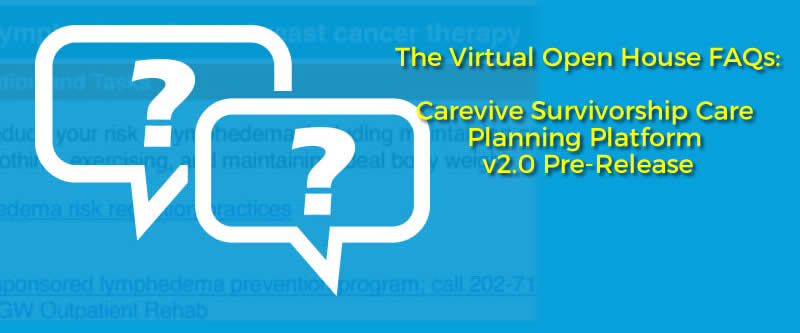
Last month we hosted a webinar titled “The Virtual Open House: Carevive Survivorship Care Planning Platform v2.0 Pre-Release” where we showcased the new version of our survivorship care planning software. Our co-founders Madelyn Herzfeld and Carrie Stricker gave an overview of the company and a demo of our software. We also invited a panel consisting of current Carevive survivorship customers to share their experiences and how they implemented our tool in their cancer centers.
Below are frequently answered questions that were compiled from the webinar registrants and attendees. .
1. Any suggestions for working with our IT team to facilitate integration?
- Get a liaison/champion from IT who supports your cause and understands the gap you are trying to fill. You will likely need to have that individual see a demo of the system
- If your system is changing EMRs or first implementing an enterprise EMR system, insist on being included in the roll-out/implementation plan so that the plans can be distributed through the patient portal
- Discourage one-off meetings (e.g., IT – vendor, clinical – vendor, internal stakeholders only) that seem to create confusion. Keep all the stakeholders involved in the conversation
“Carevive does a really good job orchestrating all the shareholders across a network system to move things along efficiently”
answered by:
Ellen A. Dornelas, Ph.D.
Director of Behavioral Health Programs
Helen & Harry Gray Cancer Center
Hartford Hospital
2. Can existing patient portals be used or would a separate Carevive patient portal be necessary?
Most enterprise EMR portals have built in flexibility that allows any patient-based “document” to be made available to patients. Carevive care plans are generated and finalized in a cloud-based software solution and then can be stored in the EMR and also accessible to the patient through your existing portal system. A separate Carevive portal is not necessary.
3. What registry systems does it interface with – what data are pulled?
Our platform is registry agnostic, meaning we can integrate with all systems using the National Cancer Registrars Association standard code sets. Typical data points pulled are (but not limited to): Diagnosis, Diagnosis Date, Stage, Pathology, Bio Markers and Laterality (where applicable), and treatment.
4. How much of the data you need to generate care plans will need to be input manually?
We believe a core competency of our architecture to be EMR integration. It really depends on what discrete data your cancer center’s EMR or registry or data warehouses generate. We will work with your IT team to evaluate what you have and get an automated feed, which we will use to generate draft evidence-based care plans that include all your cancer center resources and referral services in real-time, which you will review and finalize “in the cloud”, and then we will send the final files back to your EMR for documentation and for distribution through your portal.
5. How do we get care plans to patients that refuse to come in for appointments to receive their care plans?
Patient care plans can be sent to patients through your EMR patient portal, via email, and/or printed and sent to them through the United States Postal Service.
6. I’d like to know more about EHR integration. We are a community practice.
Our platform is completely open and capable of consuming transactional data in any format. We embed the Redox engine in our platform to facilitate easy to implement interface projects with your IT team (i.e. less expense/risk). Our typical integration involves:
- HL7 transaction for notification of a patient appointment (scheduling or pre-registration)
- HL7 transaction notification of patient arrival (scheduling or registration)
- Registry data format based on NAACR code set standard or CCD and CCDA transactions (for sociodemographic, past medical history, diagnostic and treatment information) or any discrete data sets available from your EMR or other existing data warehouses
- HL7 for sending dashboard snapshot and care plan to EMR (MDM – document message)
We are happy to follow-up with a detailed conversation with anyone because we consider integration to be a core strength of our platform.
Want a personalized tour of our survivorship platform? Click here to request a demo.



